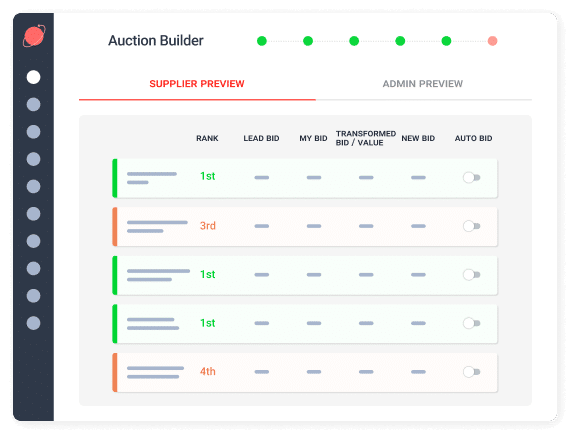Estimated reading time: 7 minutes
• One of the most significant benefits of using reverse auction software in procurement is the potential for substantial cost savings. In addition, reverse auctions can streamline the procurement process by reducing the time spent negotiating with individual suppliers. This increased efficiency not only reduces costs but also allows procurement staff to focus on strategic activities.
• Reverse auctions can improve transparency in the procurement process. Since all bids are visible, suppliers know that they are competing on a level playing field. The transparency also allows the buying company to easily justify its supplier choices to internal stakeholders.
What is Reverse Auction Software?
Reverse auction software is a digital platform that enables buyers to solicit bids from multiple suppliers in real-time. Unlike traditional auctions, reverse auctions involve suppliers competing against each other.
The lowest bidder wins in this auction, not the highest. They must offer the lowest price for the product or service. The use of this sourcing strategy in the bidding process often results in lower prices, increased transparency, and improved efficiency in the procurement process.
How Does Auction Software Work?
Reverse auction software works by allowing buyers to invite multiple suppliers to bid on a single procurement project. The suppliers are given a certain amount of time to submit their bids, and the buyer can then view the offers in real-time. The buyer can then select the supplier that offers the best combination of price, quality, and delivery time. The buyer can then award the contract to the selected supplier, thus completing the auction process.
Key Spend Categories for Indirect Spend and estimated Cost Savings by Spend Category.
The amount of cost savings achieved through the use of reverse auction software depends on the complexity of the procurement project, goods and services being procured and the number of suppliers that are invited to bid. Generally, buyers can expect to achieve cost savings of 18-40% when using reverse auction software. Additionally, buyers can benefit from improved efficiency and transparency in the procurement process.
Reverse auctions are most commonly used while purchasing and negotiating indirect spend.
Indirect spend refers to the purchases made by a business or organization that are not directly related to the production of goods or services. These purchases are necessary for the day-to-day operations of the business but do not contribute to the core product or service offering.
The main categories of indirect spend can vary depending on the industry and organization. Following are some common categories and estimated cost savings:
1. Office Supplies and Stationery (Savings of 10% to 30%): This category includes items such as pens, paper, printers, ink cartridges, envelopes, and other supplies needed for administrative tasks.
2. IT and Telecommunications (Savings of 10% to 40%): This category includes purchases related to information technology, such as software licenses, hardware equipment, computer peripherals, telecommunications services (phone lines, internet connectivity), and maintenance contracts.
3. Professional Services (Savings of 10% to 30%): This category encompasses services provided by external consultants, legal advisors, accounting firms, marketing agencies, and other professional service providers. Savings in professional services categories can vary widely depending on the specific service and market conditions. Complex services may have smaller savings
4. Facilities and Maintenance (Savings of 5% to 30%): This category includes expenses related to building maintenance, repairs, cleaning services, security services, utilities (electricity, water, gas), office rent, and facility management.
5. Travel and Expenses (Savings of 5% to 20%): This category includes expenses associated with business travel, such as airfare, hotel accommodations, rental cars, meals, and other travel-related costs. It may also cover employee reimbursement for business-related expenses. Savings in this category can vary greatly depending on the volume of travel and the organization’s negotiation power. Larger organizations with significant travel spend may achieve higher savings.
6. Human Resources (Savings of 5% to 20%): This category includes costs related to recruitment, training, employee benefits, payroll services, employee insurance, and other HR-related expenses. Savings in HR-related categories can be more challenging to quantify, as they often involve complex service agreements and long-term contracts.
7. Marketing and Advertising (Savings of 10% to 30%): This category encompasses expenses related to advertising campaigns, promotional materials, market research, digital marketing, events, sponsorships, and public relations. Savings in marketing and advertising can vary widely depending on the specific campaign or project.
8. Financial Services (Savings of 5% to 20%): This category includes expenses related to banking services, credit card fees, merchant services, insurance, and other financial-related costs. Savings in financial services can vary depending on the specific service and market conditions.
9. Utilities and Energy (Savings of 5% to 15%): This category includes expenses related to electricity, water, gas, and other utilities required for the operation of the business. Savings in this category can be challenging to achieve due to limited supplier options in certain regions.
10. Office Equipment and Furniture (Savings of 10% to 30%): This category includes expenses related to purchasing or leasing office equipment such as desks, chairs, filing cabinets, computers, printers, and other furniture items.
These percentages are approximate ranges and should be considered as general guidelines. The actual savings achieved will depend on the organization’s specific circumstances, market conditions, negotiation skills, and the effectiveness of the procurement strategy employed.
Key Steps for running a successful reverse auction
1) Clearly define requirements: Before beginning a reverse auction, the buyer must define the product or service specifications, delivery timelines, and any other necessary requirements.
This ensures that all participants in the auction are aware of the expectations. This information is then shared with potential suppliers.
2) Pre-Qualify Suppliers: Buyers should pre-qualify suppliers to ensure a successful auction. This pre-qualification should consider the supplier’s ability to meet the requirements and deliver the desired quality. This step is crucial to prevent potential issues and ensure that only reliable suppliers participate in the auction.
3. Conduct the reverse auction: Once the requirements are defined and suppliers pre-qualified, the reverse auction can be conducted using the reverse auction software. During the auction, suppliers submit their bids in real-time, continuously competing to offer the lowest price.
4. Analyze bids and select a supplier: After the auction has concluded, the buyer can analyze the bids and select the winning supplier based on factors such as price, delivery schedule, and overall value.
By incorporating reverse auction software into your strategic sourcing process, you can improve cost efficiency, streamline negotiations, and foster healthy competition among suppliers. This competitive environment not only drives down prices but also encourages suppliers to improve their service offerings to stand out from the competition.
Factors that affect Cost Savings achieved with Reverse Auction Software
The cost savings from using reverse auction software vary. Factors like industry, product type, market conditions, and supplier competitiveness all play a role. Organizations that have adopted reverse auctions as part of their sourcing strategy have reported cost savings from 18% to 40%. It is difficult to give an exact figure.
Here are some factors that can influence the cost savings achieved through reverse auction software:
1. Market conditions: The cost savings potential is often higher in industries with a larger supplier base and greater competition. This increased competition leads to more aggressive bidding, ultimately driving down prices.
2. Product or service complexity: In general, reverse auctions tend to work best for commoditized products and services with standardized specifications. These types of procurements typically have more suppliers competing, which can lead to greater cost savings.
3. Auction preparation and execution: The success of a reverse auction depends on the quality of the auction process itself. Ensuring clear communication of requirements, proper supplier pre-qualification, and effective management of the auction can all contribute to increased cost savings.
4. Supplier relationships: A key aspect of strategic sourcing is nurturing strong supplier relationships. A well-managed reverse auction process can contribute to better supplier relationships by promoting transparency and fairness in the bidding process.
Maximizing Cost Savings with Reverse Auction Software
To get the most out of your reverse auction software, consider the following best practices:
1. Set clear goals: Before initiating a reverse auction, establish specific cost-saving targets and other procurement objectives. Having a clear vision of your goals will help guide the process and allow you to measure the success of the auction.
2. Communicate effectively: Clearly communicate your requirements, expectations, and evaluation criteria to participating suppliers. This will ensure that all bidders understand the desired outcome and can submit competitive bids accordingly.
3. Train your team: Ensure they understand how to use reverse auction software. Make sure they are familiar with the strategic sourcing process. Proper training will enable your team to manage auctions effectively, leading to better outcomes.
4. Monitor market trends: Stay informed on market trends and pricing fluctuations. Industry news should also be monitored. This will help you make informed decisions during the reverse auction process. Being aware of the market conditions will help you gauge the competitiveness of bids and identify potential cost-saving opportunities.
5. Continuously improve: After each auction, evaluate the results, and identify areas for improvement. Continuously refining your reverse auction strategy will lead to better outcomes and greater cost savings over time.
Conclusion
ProcurePort Reverse auction software is a powerful and easy to use procurement tool that can significantly enhance your strategic sourcing process. By leveraging this innovative technology, organizations can achieve substantial cost savings, streamline procurement processes, and foster healthy competition among suppliers.
Adopting reverse auction software and following best practices can help maximize potential benefits. The exact cost savings, however, depend on various factors. Refine your reverse auction strategy and make the most of the technology. You will discover that reverse auctions are invaluable for strategic sourcing.












